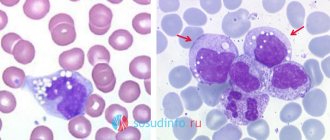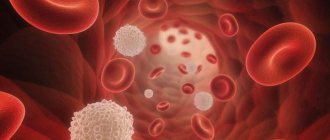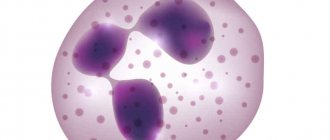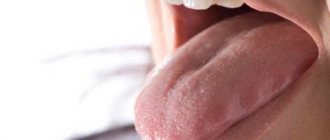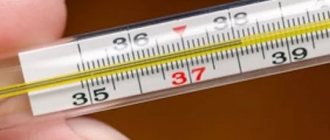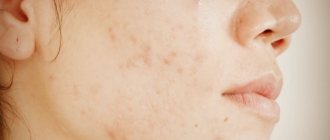Every person knows that the tongue is a mirror image of the health of the digestive organs.
The presence of a brown coating on the tongue is the first sign of concern.
It is urgent to establish the cause of its occurrence and select an effective treatment method.
Below we will look at the common causes of brown plaque and methods for eliminating it.
Reasons for the raid
There are local and general factors for the appearance of deposits on the tongue. Among the local ones, one can highlight the use of certain products that color the mucous membrane. It will also be stomatitis, which is accompanied by the formation of plaque. But there are many more common reasons. You should also take into account exactly how the plaque manifests itself - a brown spot on the tongue, staining of certain areas or the entire surface.
What factors can trigger the appearance of brown plaque:
- food colorings;
- use of bismuth preparations;
- severe form of stomatitis;
- oral thrush;
- food and drug poisoning;
- pathologies of the hematopoietic organs;
- dehydration of the body;
- Addison's disease;
- smoking and drinking alcohol;
- poor oral care;
- Frequent consumption of caffeinated drinks.
Problems with the gastrointestinal tract
Diseases of the gastrointestinal tract are accompanied by a yellow-brown coating.
Symptoms may indicate the following diseases:
- peptic ulcer of the stomach and duodenum;
- acute and chronic gastritis;
- enteritis;
- cholecystitis;
- pancreatitis.
Plaque appears in case of alcohol poisoning, as well as when chemicals and toxic substances enter the body. In chronic alcoholism, plaque is also observed.
Fungi
Green-brown and white plaque indicates a fungal infection (candidiasis, thrush). This phenomenon is quite common and is largely associated with a decrease in immune defense. When the body ceases to cope with opportunistic fungi, their active spread to the mucous membrane begins. The entire tongue becomes coated.
Glossitis
Inflammation of the tongue or glossitis manifests itself as a burgundy or bright red coating. The disease occurs as a result of injury, burns, or exposure to pathogenic microorganisms. The longer the influence of a negative factor occurs, the stronger the manifestations.
The inflammatory process can occur on the surface layer, but deep damage is also possible, up to the appearance of phlegmon or an abscess.
Liver failure
In case of kidney diseases, in particular in case of renal failure, plaque is localized mainly at the root of the tongue. The deposits are dark in color.
In severe illness, the tongue becomes covered with a brown coating. The reason is a violation of metabolic processes.
Intoxication
Plaque on the surface of the tongue may indicate severe intoxication of the body. In some cases, the symptom appears with prolonged constipation, when the body is poisoned. Initially, intoxication may manifest itself with minor symptoms.
Plaque may be the first signal of a problem. In order not to start the process, you need to find out the reason as soon as possible.
Food colorings
The simplest and most common cause of deposits on the tongue is dyes. Eating foods that are colored will cause your tongue to change color. At the same time, good hygiene saves you from such a problem.
Coffee, wine, beets, berries, sweets, and chocolate can color the tongue. Dyes are also found in colored drinks, cocktails, beer, and fruit juices.
Other reasons
Staining of the oral mucosa can occur for a variety of reasons. Failures in all organs and systems can provoke a change in shade.
What other reasons are there for tongue staining?
- smoking;
- lung diseases;
- prolonged constipation;
- fluid retention in the body;
- severe infectious diseases.
Occurrence in children
In childhood, plaque forms for the same reasons and diseases as in adults. The exceptions are smoking, drinking alcohol and using drugs.
If plaque appears, you should take into account its location on the surface of the taste organ:
- in the middle and in the root area . Most likely, the reason lies in pathological disorders and ailments of the digestive system;
- symmetrical spots . More often formed with problems with the lungs;
- tip. Disturbances in the respiratory system associated with infection and colds.
Coloring of a child's tongue can occur when eating foods that contain dyes. Often, a brown coating appears when eating food that was previously absent from the child’s diet.
Remember! If there are problems with the child’s stomach, the process of digesting food is disrupted, which inevitably leads to the appearance of a brown coating on the tongue.
Let's consider all the possible causes of black plaque on the tongue and methods for eliminating it. In this publication we will tell you why a white coating appears on the tongue in the morning.
Follow the link to see a photo of the tongue in the cracks.
Additional shades
Yellow-brown deposits indicate diseases of the digestive tract. Such plaque may be the result of many years of drinking alcoholic beverages. The phenomenon also accompanies various poisonings: food, chemical, medicinal.
A dark brown tint indicates disorders of the hepatobiliary system, that is, the liver, gall bladder, and bile ducts. In this case, additional symptoms may be present in the form of an unpleasant aftertaste, nausea, halitosis (bad breath).
Light brown is the result of diseases of the respiratory system. This phenomenon is accompanied by bronchitis and pneumonia. This may also mean problems with the lymphatic system and pathologies of the musculoskeletal system, in particular the joints.
A green-brown coating indicates a fungal infection of the oral cavity. Thrush is typical for young children, as well as adults when the defense mechanism is disrupted. A green tint also occurs with a lack of vitamins, excessive consumption of fatty and fried foods. In adolescents, this occurs during a hormonal surge.
What is it and how is it formed?
The surface of the tongue is rough because it contains small papillae.
If a person is healthy, then they are white. The tongue itself should be pink. While eating, food particles get stuck between these nipples. The result is a favorable environment for the development of a variety of bacteria. This process looks like a coating on the tongue of different shades.
https://www.youtube.com/watch?v=sc43XaENclI
The type of food can affect its color. For example, if you drink coffee or eat chocolate, it turns brown. After cleaning the mouth, it should be washed off.
If, after cleaning your tongue, the brown color does not go away or returns after a while, then you should look for the cause of this phenomenon.
The doctor, examining the oral cavity, pays attention to the color of the tongue and the thickness of the plaque:
- If the layers are thin, this means that the person is beginning to develop a viral disease.
- Thicker formations indicate that the patient has chronic diseases.
The surface of the tongue is heterogeneous. On the lower side it is completely smooth, and on the upper side there are many small processes called papillae. They serve to perceive different tastes.
The entire surface, including the papillae, is covered with a layer of epithelium. Due to normal physiological processes, epithelial cells gradually become keratinized and die. Some of them may, due to certain disturbances in the digestive process, not be washed off in time and form plaque.
In addition, during the process of eating, small particles can get stuck between the papillae. They serve as an excellent breeding ground for bacteria, which are present in the oral cavity in any case.
In the process of rapid growth and reproduction of bacteria, as well as deposition of their metabolic products, plaque is formed.
This is a very approximate diagram of the appearance of such an unpleasant formation as plaque. However, it is not only the death of the epithelium and the activity of bacteria that can cause it. There are many additional factors that contribute to this.
The color of the plaque can vary from dark brown to yellowish. It can also have different characteristics - thickness, density, location, etc.
Diagnostics
During the diagnostic process, the dentist examines the oral cavity and asks questions about nutrition, hygiene, lifestyle, medication and other issues that could cause deposits on the tongue. In addition to the color of the plaque, the doctor evaluates its thickness and accompanying manifestations.
When diagnosing, the following are taken into account:
- a thin layer of deposits – recent development of the disease, is removed during cleaning;
- a thick layer is a chronic disease, difficult to remove;
- dry mucous membrane – lack of function of the salivary glands, there may be stones in the ducts, an infectious and inflammatory process;
- a smooth, swollen tongue with marks of teeth - a deficiency of vitamins B, iodine, this could be myxedema, when the thyroid gland produces less triiodothyronine, which happens during the aging process and against the background of oncology.
Plaque deposits in certain areas are also important. The root is responsible for the digestive tract, the middle for the cardiovascular system, and the tip for the respiratory organs. Thus, after the examination, the dentist will be able to refer you to the right doctor for examination and identification of the cause.
Diagnostic measures include (depending on the clinical picture):
- general and biochemical blood test;
- stool examination;
- chest x-ray or fluorography;
- pH-metry, probing;
- Ultrasound of the abdominal organs, liver, thyroid gland.
https://youtu.be/8NaK0j7bds0
Characteristics of brown plaque
Brown coating on the tongue in adults and children has a different character.
In addition to dark, other colors of sediment may be observed, of varying consistency, thickness and location.
Color characteristics
Depending on the specific shade, there are different reasons for its occurrence, as well as accompanying symptoms. Let's take a closer look:
- Dark coating. Usually reflects the condition of the liver or spleen. The appearance of such a symptom on the tongue may be isolated or associated with concomitant ailments. Sometimes pain occurs on the left side of the lower abdomen. The symptom is accompanied by an unpleasant taste in the mouth.
- With a hint of green. If the coating on the tongue, in addition to brown, has green shades, it is more likely to be bacteria. Their development is caused by taking medications, especially antibacterial agents. Also, the reason lies in the occurrence of a fungus (candidiasis), this especially often happens in young children and adolescents against the background of hormonal changes.
- Light coating. If the shade is quite light, most likely this sign has nothing to do with the digestive organs. It usually indicates problems of the lower respiratory tract, for example, pneumonia or bronchitis of various etiologies.
- Yellow-brown. The yellow layer can be observed in people who smoke and drink. It signals a dysfunction of the liver. Perhaps the appearance of such a sign was influenced by the wrong food, frequent consumption of fatty or smoked foods.
Depending on the shade, other symptoms occur, such as a sour taste in the mouth, which is characteristic of a black or yellow coating.
Consistency
What does the condition of the tongue mucosa indicate:
- Dry plaque indicates insufficient saliva production. Sometimes this is a sign of an inflammatory process localized in the oral cavity.
- Damp coating. If the layer is soft (there is no crust), then there may be problems with the functioning of the thyroid gland. The problem is associated with hormonal imbalance, lack of microelements or B vitamins.
If the tongue begins to look swollen, an allergic reaction to food or medications is suspected.
Plaque thickness
The thickness of the brown shade determines the age of the disease:
- Thick layer. A bright brown sediment signals a long-standing pathological process, for example, a chronic form of disease of the digestive system. Attempts to get rid of the brown plaque are unsuccessful.
- Thin layer. The disease that caused the appearance of a brown coating on the tongue is recent. When cleaning, it comes off without much effort.
The location of the brown precipitate plays an important role. If it is noticeable in the root area, the problem lies in the improper functioning of the gastrointestinal tract. If the localization site is the tip or center - the cause is in the lower respiratory tract, the sides of the tongue with a coating signal a hormonal imbalance.
If your tongue is covered with a brown coating for a week, consult a doctor.
Treatment
Not everyone undergoes timely diagnosis when plaque appears. Unfortunately, symptoms that are insignificant at first glance are ignored. People usually go to the doctor when really noticeable problems appear. Then urgent treatment is required.
In fact, if you consult a doctor early, the problem can be prevented. In the mouth, the disease begins to manifest itself in the initial stages. The doctor conducts an examination and prescribes a preventive or therapeutic course depending on the existing disorders.
You need to remove brown plaque by eliminating the root cause. Regular brushing of teeth and eliminating superficial manifestations is not enough. The plaque will appear again, and the disease will worsen even more.
Treatment can be carried out by a dentist, endocrinologist, gastroenterologist, immunologist and others. As for plaque itself and its removal, the dentist will tell you about this.
Local removal of plaque on the human tongue:
- using a special brush to clean the tongue;
- rinsing your mouth with antiseptics several times a day;
- irrigation of the oral cavity with local antiseptics;
- professional hygiene at the dentist.
When the cause of deposits is local problems in the oral cavity, then professional hygiene and sanitation are required. The dentist removes tartar, treats caries, inflammatory diseases, and prescribes preventive measures.
Reviews
The appearance of a brown deposit on an unpaired organ of the oral cavity is considered a cause for concern, since these manifestations can signal serious malfunctions in the functioning of the body.
If plaque is not removed by hygienic cleansing within 5-6 days, this indicates the presence of asymptomatic respiratory or digestive ailments. In such a situation, qualified medical assistance is needed.
If you have ever encountered the problem of a brown coating on your tongue and have something to share with readers, leave your comment below.
If you find an error, please select a piece of text and press Ctrl+Enter.
Possible complications
A brownish tongue in itself is a warning sign. If we talk about complications, each cause should be considered separately.
Dental complications:
- inflammation of the oral mucosa;
- infectious lesion;
- chronic bad breath;
- frequent occurrence of oral thrush;
- damage to the deep tissues of the tongue.
Common complications:
- penetration of infection into the gastrointestinal tract;
- transition of an existing disease into a chronic course;
- weakening of immune defense;
- constant relapses.
How to get rid of it?
First of all, you should definitely consult a therapist for advice. Since it is necessary to eliminate the cause of the plaque.
After the initial examination, if certain diseases are detected or suspected of their occurrence, the general practitioner will definitely give a referral to a specialist - a pulmonologist, gastroenterologist, endocrinologist.
However, you can also use several ways to combat the unpleasant brown coating on your tongue yourself.
- Carrying out thorough oral hygiene. Moreover, you need to completely clean all surfaces, including teeth, gums, the mucous membrane of the inner surfaces of the cheeks, and so on.
- Antiseptic rinses. They should be carried out regularly, both after cleaning and in between, that is, 5-6 times a day.
For rinsing, decoctions of medicinal plants in medium concentrations are most often used. Used: oak bark, chamomile, oregano, plantain, yarrow, linden.
A decoction made from flax seeds can eliminate minor problems in the digestive system.
Prevention
To prevent the formation of plaque, you should engage in general prevention, strengthening the immune system and timely treatment of existing diseases.
General recommendations for dealing with deposits on the tongue:
- varied diet, daily consumption of fresh vegetables or fruits;
- sufficient fluid intake;
- thoroughly cleaning the tongue in the morning and evening, rinsing the mouth after eating;
- taking a course of vitamin therapy;
- walks in the fresh air, good sleep, physical activity;
- intake of sorbent products: bran, pumpkin, rye bread;
- limiting alcoholic beverages and smoking.
General prevention also includes regular examination by a dentist and therapist. Dental visits often reveal hidden diseases.
https://youtu.be/Rz-4we2Ysx4
Causes
It can appear as a result of eating dyed foods or as a result of the development of serious chronic illnesses.
As a rule, a brown tint indicates digestive disorders. The more intense it is, the more acute the stage of the disease.
Let's look at the reasons that are not a serious cause for concern.
Smoking
Heavy smokers stain not only their fingers, but also their teeth. Coloring components appear as dark brown spots. Traces remain after intense smoking on the tongue.
The resins contained in tobacco can change the natural shade of the mouth. Therefore, after smoking, you can see an uneven dark coloration of the tongue.
If you notice that your tongue has turned an unusual color, then remember what medications you have taken recently. Many of them give such a side effect, and information about this can be found in the instructions for the drug.
Products that form light and dark brown deposits include:
- Faringosept. Prescribed for throat diseases or for the treatment of sore throat.
- Malavit. After finishing taking it, the natural shade returns.
- Antibiotics. They also give a brown color, after completing the entire course, the side effects go away.
Brown plaque that has formed as a result of taking any medications is not a reason to stop therapy or change the drug.
Treatment methods
Before the doctor prescribes treatment for you, he will conduct laboratory and maybe endoscopic examinations. The most effective way is to find out what caused the gray plaque, and then begin the full course of treatment.
If the doctor suspects diseases from the respiratory system, he will prescribe you a course of physiotherapy, and if from the digestive system, he will suggest you see a gastroenterologist for a more extensive examination.
Experts can also determine the problem by looking at the condition of your tongue. They will evaluate you according to special criteria; it is from this examination that the doctor will be able to determine exactly why you have a gray coating.
View. Plaque from any disease can be dry or wet. Localization. It is the gray coating that can be located in spots of different shapes.
Thickness. In a healthy person, plaque on the tongue does not have a pronounced color and is located in a thin layer.
If it has changed its natural color and remains thin, this may indicate that the disease has not yet had time to spread throughout the body, and it may also indicate a cold. A thick gray coating sometimes does not allow one to see the natural color of the tongue - this also signals a chronic disease.
An infectious disease may also occur without symptoms.
If a specialist suspects plaque due to oral candidiasis, simple manipulations are used. First you need to get rid of the fungal infection itself in the body, gradually moving on to eradicating plaque in the oral cavity. You may be prescribed clotrimazole ointment or amphotericin ointment.
A good and effective way is carrot juice: it is what removes and treats plaque. This method is also effective and useful for treating plaque in very young children, especially since it is tasty and does not cause disgust or allergies. You need to wipe your tongue with this tincture as often as possible.
Prevention is also important for this symptom. It includes:
- Compliance with the rules of oral hygiene (constantly brush your teeth, namely in the evening and in the morning - use antibacterial rinses on the tongue).
- Monitor your food intake (try not to eat foods such as fried, spicy, sour foods during this symptom; at the same time, eat more fruits and vegetables).
The priority is to monitor what you eat, because the cause of a gray coating on the tongue is a disruption of the gastrointestinal tract.
Also, to prevent such a problem, it would be ideal to completely quit smoking and alcoholic beverages.
Timely contact with a qualified specialist, correct and accurate diagnosis are important for eliminating gray plaque.
Be more attentive to yourself when brushing your teeth, try to monitor the condition of your tongue.
Plaque on the tongue caused by poor oral hygiene can be easily removed. If a symptom is caused by a separate disease, then it is necessary to treat the underlying pathology, otherwise it will not be possible to achieve a positive result.
To eliminate plaque, a number of medications are used that help get rid of the disease that caused this manifestation. Plaque caused by poor hygiene can be removed by thorough brushing of the teeth and tongue.
This can be done using a regular brush designed for such procedures.
Plaque must be removed starting from the root of the tongue, but without affecting the papillae. Just 10 movements towards the teeth. After each time, it is advisable to rinse the brush with warm water. And at the end of the procedure, wash thoroughly with soap.
To remove plaque, use a toothbrush with soft or medium-hard bristles. The procedure should be performed only after preliminary brushing of the teeth.
Manipulation can be carried out using a special rubber device to remove plaque from the tongue. It can be located on the back of the toothbrush, or you can purchase it separately. This device helps clean not only the tongue, but also the inner surface of the cheeks.
Drug therapy
To eliminate plaque caused by various diseases, the following groups of drugs are used:
- Pancreatic enzymes. Used for pancreatitis in acute or chronic form. These drugs help reduce the load on the pancreas. Medicines contain enzymes that help break down proteins, fats and carbohydrates. Most often prescribed are Mezim, Creon, Pancreatin, etc.
- Proton pump blockers. They reduce the production of hydrochloric acid by stomach cells, resulting in regeneration of the mucous membrane. Such drugs are prescribed for gastritis with increased secretory function and peptic ulcer. Most often, Omez, Nolpaza, Emanera, etc. are used for treatment.
- Choleretic and hepatoprotectors. Most often, combination drugs are prescribed. They affect the gallbladder, stimulating its work, and also restore liver cells. Such medications include Hofitol, Ursofalk, etc.
- Antifungal. Used when the cause of plaque is thrush. The most effective: Mikomax, Fluconazole, etc.
- Local antibiotics and antiseptics. They help with sore throat, eliminate microbial flora and prevent plaque formation. They prescribe both lozenges: Grammidin, Lizobakt, etc., and rinses: Miramistin, Chlorophyllipt, etc.
To eliminate plaque on the tongue and maintain a normal acid-base balance in the oral cavity, rinses such as Listerine, Colgate, and Fluorodent are used.
Therapy for deposits on the tongue depends on the reasons for the appearance of such spots. The easiest way to get rid of this phenomenon is if it was caused by dehydration or poor nutrition. Then treatment consists of restoring water balance and revising the diet.
In other cases, the following therapy will be required:
- For bronchitis and inflammation of the respiratory tract, a course of antiviral drugs and antibiotics is prescribed.
- If the spots appear due to disorders of the gastrointestinal tract, then choleretic agents, as well as antacids and probiotics, are prescribed. Such drugs are prescribed by a gastroenterologist.
- If the deposits are caused by a decrease in immunity or taking medications, then a course of immunostimulants and vitamin complexes is prescribed.
- Antiseptic and antimicrobial drugs will be prescribed by the dentist for inflammation caused by insufficient oral hygiene.
Remember, the sooner you diagnose the cause of the formation of gray spots and begin treatment, the easier the therapy itself will be.
Vitamin B deficiency
The first symptoms of B vitamin deficiency are:
- dark brown coating on the tongue;
- formation of cracks in the mucous membrane of the muscular organ.
https://youtu.be/Gzye77zU1RY
In the absence of the necessary treatment, the layers on the tongue become thicker and become red in color. A lack of B vitamins requires urgent treatment, since a deficiency state can lead to the development of serious diseases, for example, Addison's disease, pellagra or diabetic coma.
Gray coating on the tongue
A gray coating on the tongue often indicates a disease of the oral cavity or pathology of the digestive system. It is considered a normal manifestation only in cases where it is not intense and can be eliminated without pain with a toothbrush. This often happens in the morning and disappears completely throughout the day.
There are a large number of predisposing factors against which such a symptom appears. If the source is a disease, then a coating on the tongue will not be the only manifestation of a particular illness.
Only a clinician can determine the causes of its appearance, based on a physical examination and data from laboratory and instrumental diagnostic examinations. The elimination of such an unpleasant symptom is individual in nature, depending on what served as the source of its formation.
Gray coating on the tongue is a sign that has no restrictions on age and gender, which is why it can appear even in children.
Predisposing factors for the appearance of such plaque in adults include:
- disruption of the functioning of the gastrointestinal tract, in particular the pancreas;
- sore throat - a grayish tint of plaque is caused by the settling of pathological bacteria on the tongue;
- indiscriminate use of certain medications for no apparent reason or in non-compliance with the dosage prescribed by the attending physician. Such medications are antibiotics or hormonal agents;
- chronic inflammatory processes in the oropharynx;
- HIV infection;
- respiratory diseases, such as pneumonia, bronchitis or tracheitis.
Often, a gray coating may be accompanied by a coating of other shades. Gray-white coating indicates:
- severe kidney pathologies, often leading to chronic or acute renal failure;
- peptic ulcer of the stomach or duodenum;
- leptotrichosis;
- pustular psoriatic erythroderma;
- acute form of gastritis.
Gray-yellow plaque is a manifestation of:
- exacerbations of chronic diseases of the stomach or intestines, which are accompanied by increased secretion of hydrochloric acid;
- liver cirrhosis;
- dysfunction of the gallbladder;
- inflammatory process in the pancreas;
- parasitic infestations;
- glossitis.
The appearance of a gray-green tint can be caused by:
- liver pathologies;
- decreased immune system resistance;
- the presence of fungal infections;
- an increase in the level of bilirubin in the blood;
- long-term medication use.
The most rare combination - a gray-brown coating on the tongue occurs against the background of:
- long-term addiction to alcoholic beverages and smoking;
- peptic ulcer;
- lung damage.
In children, a gray coating on the tongue is caused by:
- diseases of the gastrointestinal tract;
- chronic form of tonsillitis;
- the course of scarlet fever;
- diphtheria.
These are characteristic factors in the formation of such a manifestation depending on the age category. However, there are several common causes of gray coating on the tongue. Among them:
- dehydration of the body;
- non-compliance with oral hygiene rules;
- addiction to bad habits - in adolescents and adults;
- poor nutrition – eating a lot of fatty and spicy foods;
- iron deficiency.
Symptoms
Since a gray coating on the tongue, in the vast majority of cases, indicates the occurrence of some pathological process, it will not be the only manifestation of the clinical picture. Other signs include:
- dry mouth;
- extreme thirst;
- pain syndrome of varying intensity, localization location - projection of the affected organ;
- belching with an unpleasant odor;
- heartburn and burning behind the sternum;
- attacks of nausea and vomiting;
- changes in temperature, blood pressure and heart rate;
- the appearance of an unpleasant taste or bad breath;
- pallor or yellowness of the skin;
- the appearance of deep cracks in the tongue.
Read also: What is pipun
These are just the main symptoms that may accompany a gray coating on the tongue. The clinical picture is different for each patient.
Preventive measures
Plaque should not be left unattended, as it is an excellent breeding ground for various pathogenic bacteria. As it appears, you need to get rid of it by carrying out the necessary hygiene procedures. Additional preventive measures will slow down its formation.
- Get treatment from your dentist promptly. Caries, gum disease - all this can provoke the formation of plaque.
- Pay attention to your health - take multivitamins, spend more time in the fresh air, give up bad habits.
- In the morning, drink a glass of clean water on an empty stomach.
- Review your diet by eliminating excessive amounts of sweet, carbohydrate-rich foods.
- Limit the amount of coffee and strong tea you drink.
- Consume fermented milk products enriched with bifidobacteria as often as possible to normalize intestinal function.
If you follow all these rules, but the plaque does not go away, then consult a therapist. Having made a preliminary conclusion, he will refer you to an appointment with a specialist - a dentist, gastroenterologist or otolaryngologist.
Be sure to examine your tongue every morning so you can respond to changes in your body in time. And so that you know in what cases to sound the alarm, we suggest you watch a video that will tell you what the appearance of plaque on the tongue means.
https://youtu.be/cZHM94R-Q_M
Characteristics
If you evaluate plaque based on its characteristics and features, you can determine the cause of its formation and preliminarily recognize the disease itself.
Brown plaque can be characterized by various shades, which will indicate the presence of a particular ailment:
- Light brown. It occurs due to diseases of the respiratory system, that is, the organs that provide the function of external respiration.
- Dark brown. Temporary intensification of existing and appearance of new symptoms associated with the dynamics of diseases of the gastrointestinal tract, kidney disease, ARVI, exicosis (a pathological condition of the body caused by a decrease in the amount of water in it), vitamin deficiency.
- Yellowish tint. Alcohol abuse, regular digestive disorders, negative effects of medications.
Based on localization, the brown tongue surface is divided into two types:
- Local. This indicator on the tongue is characterized by the presence of spots in some areas.
- Diffuse. Plaque covers the entire tongue with a veil.
The thickness of the layer of keratinized epithelium can be:
- Thick. Indicates the presence of a chronic disease that has progressed to the acute stage. Also, this signal from the body may indicate the presence of characteristic signs of an infectious disease. The deposit is difficult to clean off during hygiene procedures.
- Thin. Signals about the initial stage of diseases of internal organs and viral infections.
Depending on the degree of thickness and nature of the consistency, plaque can be:
- dry;
- wet;
- scanty;
- bold.
Usually, the degree of density indicates the course of the disease and its characteristics.
Separation from the taste organ occurs:
- Light. The disease is at the primary stage; with proper and timely treatment, the symptoms and manifestations will quickly disappear.
- Complicated. Indicates an exacerbation of a chronic disease, that is, a worsening of the causes.
The characteristics or criteria for assessing plaque will help you navigate the reasons for its appearance and approximately determine why it is formed.
The specific characteristics of this phenomenon make it possible to most accurately diagnose what kind of health problems the patient has.
An experienced specialist, already in the process of visual examination, will be able to identify the disease with a high degree of probability based on the following signs:
- Shade – A darker color indicates poor lymphatic drainage, respiratory dysfunction, or arthritis.
A light yellow tone will indicate a chronic alcoholic, gastrointestinal tract abnormalities, as well as toxic damage from medications and chemical components. The dark chocolate shade provokes pathological changes in the tissues of the liver, gall bladder, and kidney failure. - Thickness – the thinner the film, the less severe the disease.
Very often, it is the presence of a barely detectable visual film that manifests an allergic reaction to an external irritant. If the layers are too thick, through which the natural shade of the organ is poorly visible, this is an alarming signal. This happens in the presence of severe chronic pathologies and advanced infections. - Location – There are two localization options. Local - less common, with only minor areas of the organ covered with a dark coating. Full – covers almost the entire area. In medical terminology it is interpreted as diffuse.
- Consistency - in most cases does not depend on the intensity of the shade. It can be either excessively dry or quite wet. It is on this basis that the nature of the disease is judged.
- Ease of release - deposits that can be easily washed away during morning brushing of teeth - is not a reason to worry. In other cases, everything is quite serious.
If an attempt at self-removal is unsuccessful, the next best thing is to get examined.
Fact No. 2: brown color is one of the signs of problems with internal organs
A brown coating on the tongue in adults or children has different causes, but almost always indicates that at least one of your internal organs has become infected. And, with a greater degree of probability, of all possible cases, the problem is localized in the intestines or stomach 1.
Important!
The surface of the tongue is covered with microscopic papillae, which are actively involved in determining various taste sensations. On top, the papillae are protected by a thin epithelium, which, with good immunity, constantly dies and is renewed. If disturbances are detected in the body, the epithelium becomes denser and ceases to renew itself. And given that the smallest particles of food and plaque periodically settle on it, the mucous membrane becomes the best and most convenient environment for the proliferation of bacteria.
When to worry
The appearance of a gray plaque does not always indicate the presence of serious pathologies.
After all, a thin film often forms after a night's sleep or during the hot season. But if the layer is dense, grows quickly and cannot be removed using normal hygienic methods, then you should pay attention to your health condition. In addition, you should seek medical help in cases where gray plaque is accompanied by the following symptoms:
- putrid odor from the mouth;
- painful cracks form;
- severe oral irritation;
- excessive dryness of mucous membranes;
- elevated temperature;
- the appearance of purulent ulcers.
https://www.youtube.com/watch?v=MQPdS7IZ-xQ
You should take a closer look at your health if spots form not only in the morning, but throughout the day. In addition, you should be concerned when the layers begin to increase in size and darken.
What does plaque on the tongue mean and how to eliminate it?
For most people, a coated tongue is normal. In fact, the color of a healthy tongue is pinkish, without spots or deposits. Only a slight pale white plaque that forms at night and is easily washed off with regular brushing of teeth is considered acceptable. The appearance of plaque of a different color can be due to a number of reasons. Its presence is a sign of improper functioning of the body. This means that it is necessary to fight not so much with the plaque itself, but with the cause of its appearance.
What kind of coating is there on the tongue?
Depending on the color, plaque is divided into:
The color of plaque directly indicates the presence of a specific disease.
A white coating may be an indicator of the presence of such ailments:
- chronic constipation, caused by an inflammatory process in the gastrointestinal tract;
- effects of toxins on the intestines;
- inflammatory processes in organs such as kidneys or lungs;
- infection;
- diseases of the urinary system and pathologies of the gastrointestinal tract.
The presence of a green coating on the tongue may indicate the following problems:
- damage to the oral mucosa;
- immunodeficiency;
- bacterial infections.
What does a gray or black coating indicate:
- stomach diseases. It may even indicate a peptic ulcer;
- dehydration;
- excess mucus;
- particularly severe diseases of an epidemiological nature, for example, cholera.
- stomach ulcer;
- damage to the body by worms;
- hepatitis and biliary diseases;
- inflammatory processes.
Brown plaque is observed in the following cases:
- disruption of the spleen and stomach;
- pulmonary diseases;
- in heavy smokers;
- in chronic alcoholics.
The blue coating also deserves attention. Its appearance may mean:
- problems in the functioning of the cardiovascular system;
- blood diseases;
- stroke;
- dysentery and typhus.
Causes of plaque on the tongue
The covering of the tongue consists of numerous papillae, varying in shape and size. It is between them that a small amount of food remains after eating. Due to this, bacteria in the oral cavity receive nutrition and form plaque.
Healthy plaque can also change in thickness and color at different times of the year. In winter it turns a little yellow, and in summer it becomes denser. Naturally, the color is also affected by what a person eats or drinks. A change in plaque color after drinking a cup of coffee or eating blueberries should not cause alarm.
There are several signs by which plaque is distinguished:
- color;
- view;
- thickness;
- localization;
- ease of separation from the tongue.
Read also: White pimple on the tongue
It will not be difficult for an experienced doctor to identify the disease by these signs. But the color of the plaque speaks most accurately about the functioning of the body.
Dehydration
Dehydration or dehydration most often occurs after disturbances in the gastrointestinal tract, accompanied by diarrhea. During loose stools, the body loses a large amount of fluid and vital microelements and vitamins. If their balance is not replenished in time, this can lead to serious health problems.
Signs of dehydration:
- scanty volume of dark yellow urine;
- increased sweating;
- constant feeling of thirst;
- dry mouth and brown coating on the tongue.
As dehydration progresses, presyncope and fainting conditions are observed. In this case, emergency medical attention is required.
Causes of gray coating on the tongue in adults
The appearance of a gray coating on the surface of the tongue should alert a person and become a reason for an early visit to a gastroenterologist. Of course, not every shade of plaque signals the presence of problems in the body, but it is still worth consulting with a specialist.
A person should be especially wary of the density of plaque; the stronger it is, the more serious the problems in the body. If gray plaque is easily removed from the surface of the tongue during oral hygiene procedures, then most likely this signals the usual slagging of the body and does not pose a threat to life. However, if the plaque does not remove and is present on the surface of the tongue around the clock, intensifying after a night's sleep, then it is worth a comprehensive examination.
Preventive actions
The tongue of a healthy person is evenly colored, slightly moist, and pink. For both children and adults, the norm is a thin, transparent, slightly whitish coating that does not have an unpleasant odor. It may be more intense in the morning. On the surface of the tongue, which is coated with plaque, dead epithelial cells and food debris accumulate, which allows bacteria and microbes to multiply. Therefore, plaque must be carefully removed in the morning. You can use a regular toothbrush or a special one with silicone bristles located on the back of the head.
It is recommended to rinse the mouth with antiseptic preparations, herbal decoctions of calendula, chamomile, sage, and yarrow flowers.
To prevent stress, which provokes many diseases, and to improve immunity, you need physical exercise and fresh air. To maintain normal intestinal microflora, prevent peptic ulcers, gastritis, vitamin deficiency, you need to take B vitamins, organize a nutritious diet and establish a proper diet.
Each person should limit alcohol consumption, exclude chips, smoked meats, fatty sauces, buns and cakes, and sweet soda from the diet. You need to brew herbal teas more often in the morning, drink vegetable and fruit juices, include fermented milk products, fresh vegetables, herbs and fruits in your daily diet, which saturate the body with vitamins and help cleanse the oral cavity.
The reason for the appearance of brown plaque on the tongue, which cannot be removed with a toothbrush, is the development of a pathological process in the body. Preliminary diagnosis can be carried out independently by color, shade, localization and intensity of plaque, but an accurate diagnosis of the disease is made on the basis of a medical examination.
https://youtu.be/aGv4LYNHQEI
Brown coating on the tongue in adults is a problem that many men and women face. This phenomenon indicates the presence of serious health problems. Among the latter are not only diseases of the oral cavity, but also pathologies of the gastrointestinal tract, lungs and autoimmune infections. That is why it is so important to know what can cause a brown coating on the tongue, what diseases it is associated with, and how you can get rid of it. So, depending on the causes, you can get rid of plaque through medications, rinsing or mechanical cleaning of the tongue. Read further in the article for details.
Diagnosis of diseases by language
To find out exactly what disease led to the appearance of a dark coating on the tongue, you need to consult a doctor. First of all, it is better to visit a therapist who will conduct an examination and collect the patient’s medical history. The patient's abdomen is palpated, the function of the lungs and heart is listened to, and bad habits, diseases, and injuries are also found out. Based on these data, the therapist will give a referral to a specific specialist.
The patient may be prescribed the following examinations:
- general blood analysis;
- blood chemistry;
- urine and stool analysis;
- fluorography;
- Ultrasound of internal organs;
- gastroscopy, etc.
Most often, the patient has to visit a gastroenterologist who specializes in diseases of the gastrointestinal tract. A referral to an infectious disease specialist and endocrinologist may also be issued.
Gastroscopy allows you to examine the mucous membrane of the esophagus and stomach using a special endoscope
The appearance of spots on the tongue is a symptom, not a disease. Therefore, in order to get rid of them, it is necessary to eliminate the root cause of such a symptom. And for this, first of all, you should contact a therapist.
Based on the initial examination, the doctor will make a presumptive diagnosis and, if necessary, refer to a specialized specialist who will prescribe additional tests:
- general blood analysis;
- biochemical composition of blood;
- analysis for the Helicobacter bacterium if a gastric ulcer is suspected;
- Ultrasound of the abdominal cavity;
- fibrogastroduodenoscopy;
- coprogram;
- sowing the oral cavity for flora.
Language is an indicator of the state of the human body. Based on the color, density and dislocation of plaque, an experienced doctor will be able to learn a lot about the patient’s health.
- The heart is the tip of the tongue;
- Spleen - middle part, closer to the base;
- Liver and gall bladder - lateral parts;
- Lungs - middle part, closer to the tip;
- The intestine is the root.
Often it is enough to normalize your diet, and the plaque disappears on its own. But in certain situations, treatment may be necessary, especially if it involves a condition of the heart, lungs or kidneys. In this case, the diet does not eliminate the dense layer of deposits.
For an accurate diagnosis of the tongue, only the location of the plaque is not enough; its density plays an important role.
Classification
Not only the shade of plaque on the tongue can indicate one or another reason for its occurrence. Doctors will be provided with quite a lot of information about the location of the gray plaque on the tongue:
- tip of the tongue – lung disease or pathology of the cardiovascular system;
- root of the tongue – intestinal or kidney diseases;
- on the lateral surfaces - impaired functioning of the liver or gall bladder;
- the center of the tongue is a lesion of the spleen.
In addition, doctors pay attention to the fact that the more intense the plaque, the more severe the course of a particular disease.
Such coating on the tongue is also distinguished depending on its prevalence:
- the tongue is completely covered with a gray coating;
- forms spots on the tongue;
- appears in small dots.
How to remove plaque on the tongue?
To eliminate plaque, you first need to find out the reason for its appearance.
Removing plaque as such will not give the desired result. If you do not eliminate the factor in connection with which it appeared. The most common causes of plaque are:
- Sore throat and other infectious diseases.
- Improper liver function.
- Intestinal dysfunction.
- Failure to comply with basic nutritional rules.
For sore throat and various infectious diseases, it is necessary to treat the mucous membrane by eliminating those symptoms that lead to dry mouth. It is recommended to lubricate the mucous membrane with an emulsion containing peach oil and rinse your mouth with strong tea. In case of severe inflammation of the gums, the first step is to remove the root cause - allergies and stomatitis. Only after this should you start using Karotolin, rosehip oil and sea buckthorn.
If plaque appears due to constipation, you should resort to using laxatives:
- The intestines are cleansed. After all, it is stagnation that leads to all sorts of problems not only with digestion, but also in the oral cavity.
- Magnesia or an enema will have a beneficial effect on the intestines. This will give a much greater effect than herbal preparations that act longer.
- Particular attention is paid to nutrition. Certain foods can negatively affect intestinal function and, accordingly, contribute to the appearance of plaque. They should be excluded from the diet.
If following a diet gave positive results, the cause of the plaque was precisely a malnutrition. But if the desired effect is not visible, you should go to the doctor to prevent complications of the disease.
To diagnose and cleanse the tongue of plaque, there are several proven and effective methods:
- Use a toothbrush to clean the entire oral cavity. The tongue is cleaned especially carefully. The mouth is rinsed with a product that is intended for these purposes. A few hours after these manipulations, you should observe whether the plaque has reappeared. If it appears, there is a high probability of diseases of the gastrointestinal tract, and accordingly you should seek help from a gastroenterologist.
- The use of choleretic drugs. An excellent remedy of natural origin is “Allohol”. It should be taken three times a day, a couple of tablets. The entire course of treatment lasts about a month, but in case of stagnation of bile in the body, the positive effect will be noticeable after the first week of use.
- has an excellent effect on the gastric mucosa and normalizes the functioning of the digestive system. It should be taken daily half an hour before the first meal.
- Improving digestion in most cases allows you to get rid of plaque on the tongue. It is for this purpose that drugs such as Mezim or Pancreatin are taken.
There are also traditional methods of treating plaque:
- Mix a tablespoon of mint, sage and chamomile and pour in a full glass of boiling water. The broth is infused for about half an hour, chilled and filtered. To get rid of plaque, you should rinse your mouth with this decoction after every meal.
- A glass of boiling water is poured into a full spoon of oak bark and heated in a water bath for about half an hour. After complete cooling, the broth is filtered. Use it to rinse the mouth after each and every meal, even if it was a light snack. This decoction will not only strengthen the gums, but also cleanse the tongue of plaque.
- Rinsing the mouth with regular vegetable oil . The procedure should be repeated a couple of times a day. The duration of each is 10 minutes.
- flax decoction before your morning meal . To prepare it you need a tablespoon of these seeds. They are poured with boiling water and left for a couple of hours.
- Propolis is used to rinse the mouth . To obtain a solution, you need to dilute a few drops of propolis in warm water.
Read also: Pimple on tongue causes

